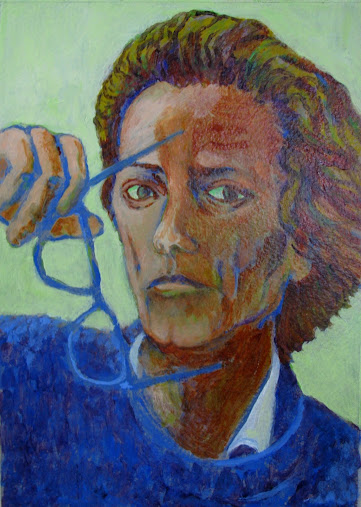Inspired by the imagination and commitment of D, a young "creative" and ardent enthusiast of diggers and words, I've been paying close attention to construction sites. (D's grandmother, in her witty accounts, tells me that at age 3, he's a seasoned site supervisor on every dig in their North Shore vicinity.)
As I hope for a little more than the mud and clay of the old Tea Swamp not far from my place (photo above and also here) I'm reminded of the words of artist-author Donald McIntyre:
"Painting is ultimately a bit like mining. You explore and explore; then it dries up and you keep on like an idiot, hoping that something else will come along…Every now and then, you do a painting which is the start of something different in your life."
My own recent diggings are guided by my plan to answer a key question I've posed: -- Do my paintings work best in a linear style or a painterly style, or my own combination of both? (This link by the way is a wonderful brief synopsis of what the heck I'm talking about.) My aim: To do a series of paintings modelled on painters I admire who work in various mixes of linear/painterly styles -- and eventually draw some conclusions about my own style.
You might have caught my first try, based on the flat linear style of painter Alex Katz – "The Jury is Out (Alex)".
For the second in the series, I reconnected with a painter whose works I *love* -- Ferdinand Hodler. I'd discovered this early 20th c. Swiss artist a few years ago when I emulated his style with a painting which I based on a photograph of Richard Avedon.
This time, I viewed a lot of Hodler paintings on line, like these. His "Portrait of Gertrude Muller" led me to a working hypothesis.
Many of his figure paintings are very linear and dynamically coloured, against a rather flat and plain background – one step beyond Alex Katz in terms of presenting a 3-dimensional impression on a 2-dimensional surface. I did some preliminary planning and got started.
I smiled at my early stage, based on a sitting figure I photographed ...somewhere.
About halfway along, I realized I'd made a big mistake. The eyes were just too low on the head.
There's a general guideline that helps with placement of features – and it's a halfway point itself. Yes, of course, human faces vary -- but most show the middle of the eyes at about half the height of the head.
Groan. There was only one thing to do.
When the paint dried, I tried again and came closer.
As I worked towards the finish, I considered the title for this second piece in my "Jury is Out" series. I've imagined art students waiting to learn the fate of their submitted portfolios, with their first names the same as the artists I'm imitating. But here's the thing:-- I don't like the name Ferdinand. I don't like the nicknames Fred, Freddie, Fredo.
But wait! Here's a little known nickname for Ferdinand:-- "Nando." Really! But will he be confused with Nandi, the young prodigy? What the heck – the guy in my painting looks a little preoccupied and needs a goofy nickname to cheer himself up. Here he is in "The Jury is Out – Nando" (copyright 2021).
I'm not entirely happy with this. I could have done something much more exuberant along Hodler's lines -- like his gorgeous painting, "The Joyous Woman."





























